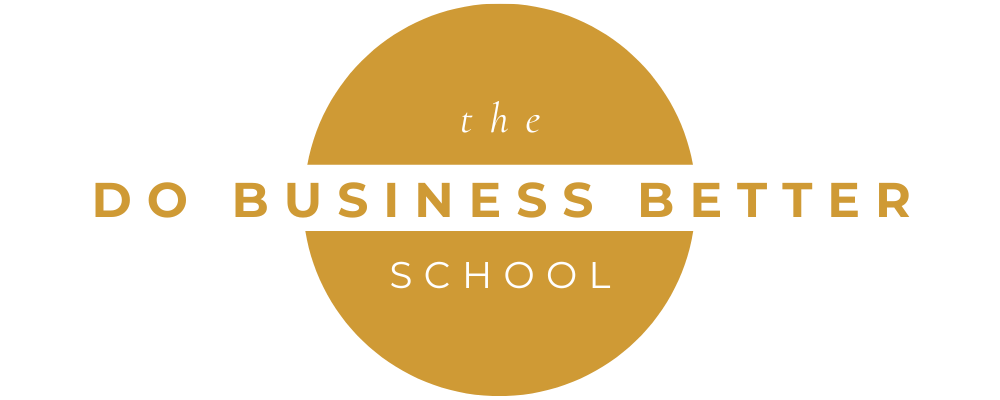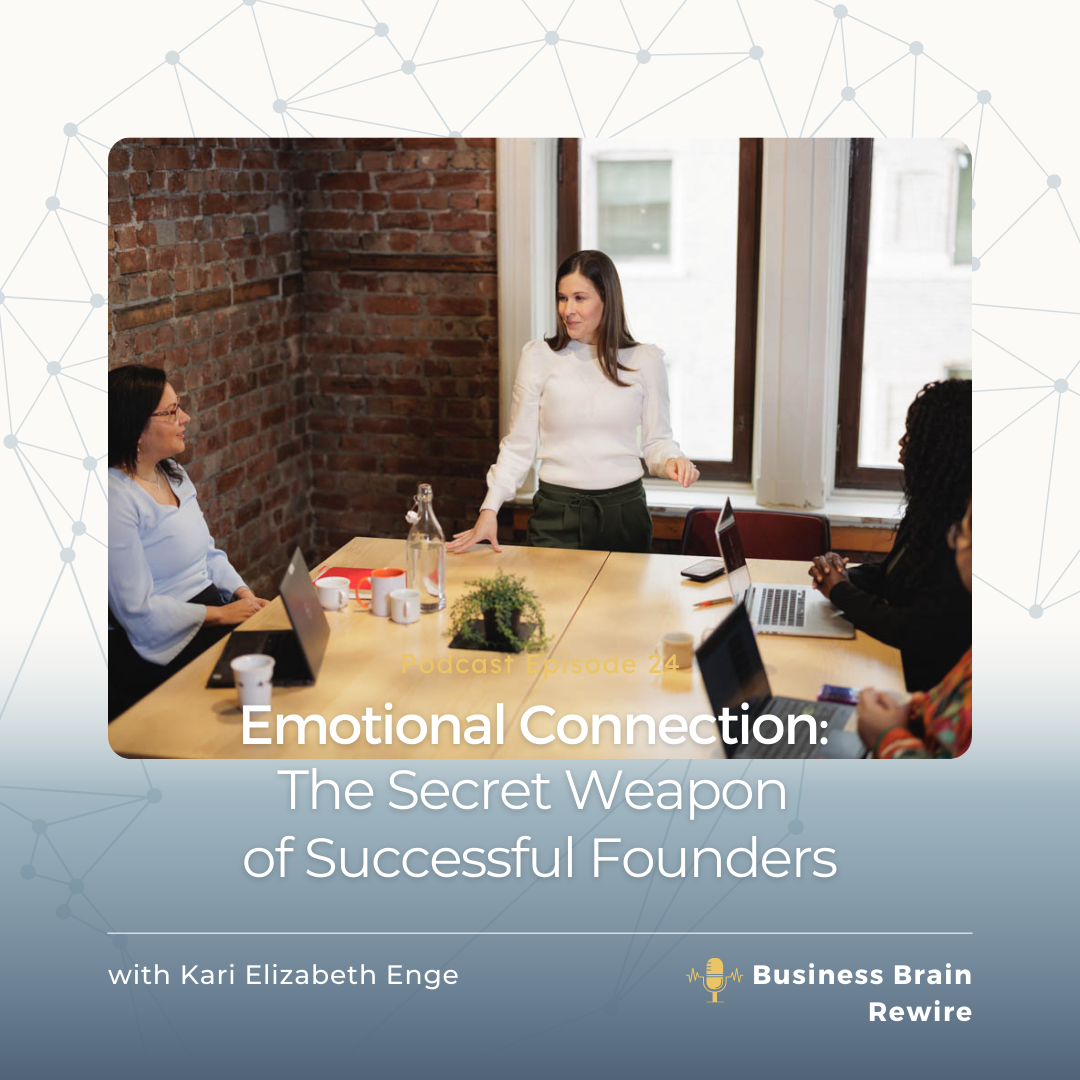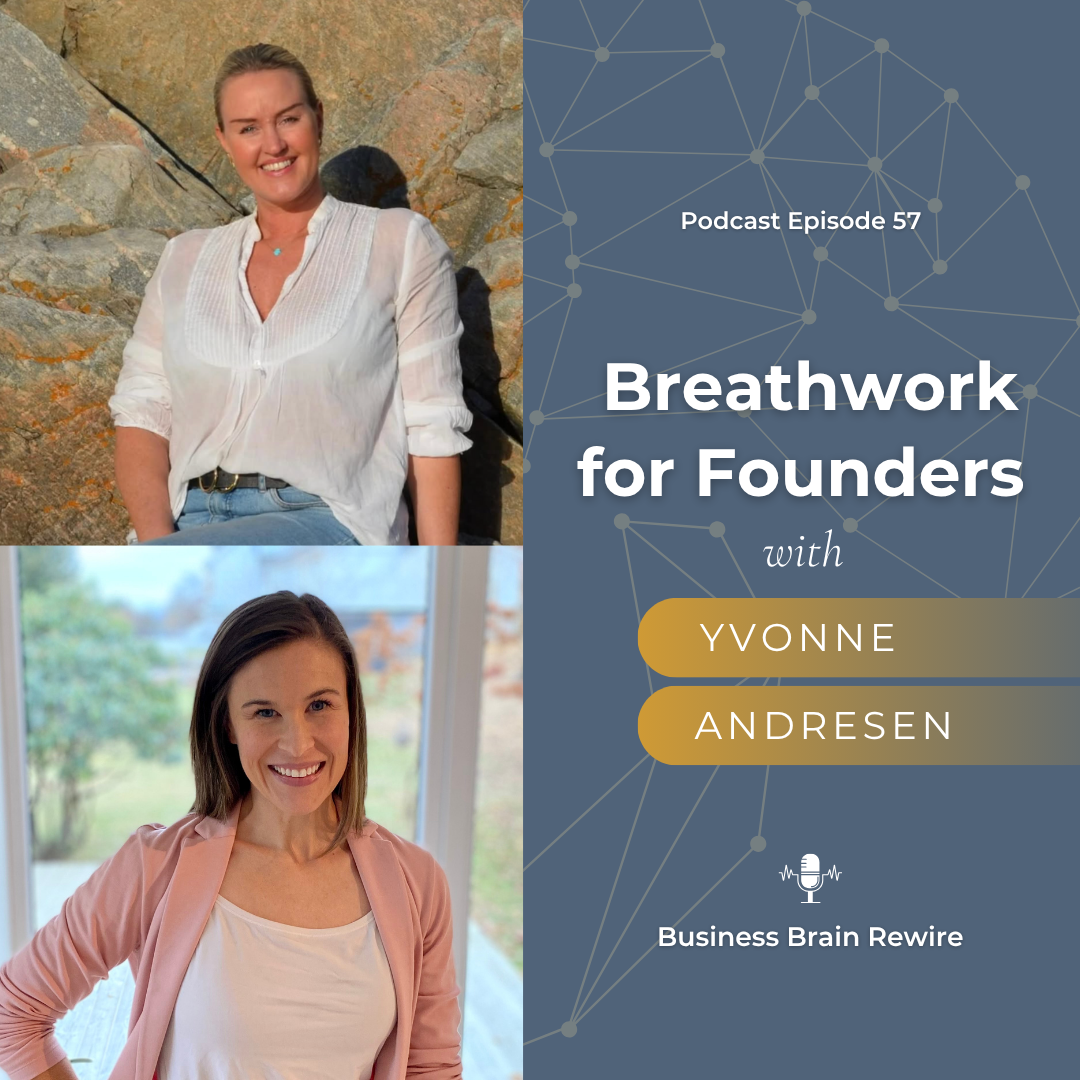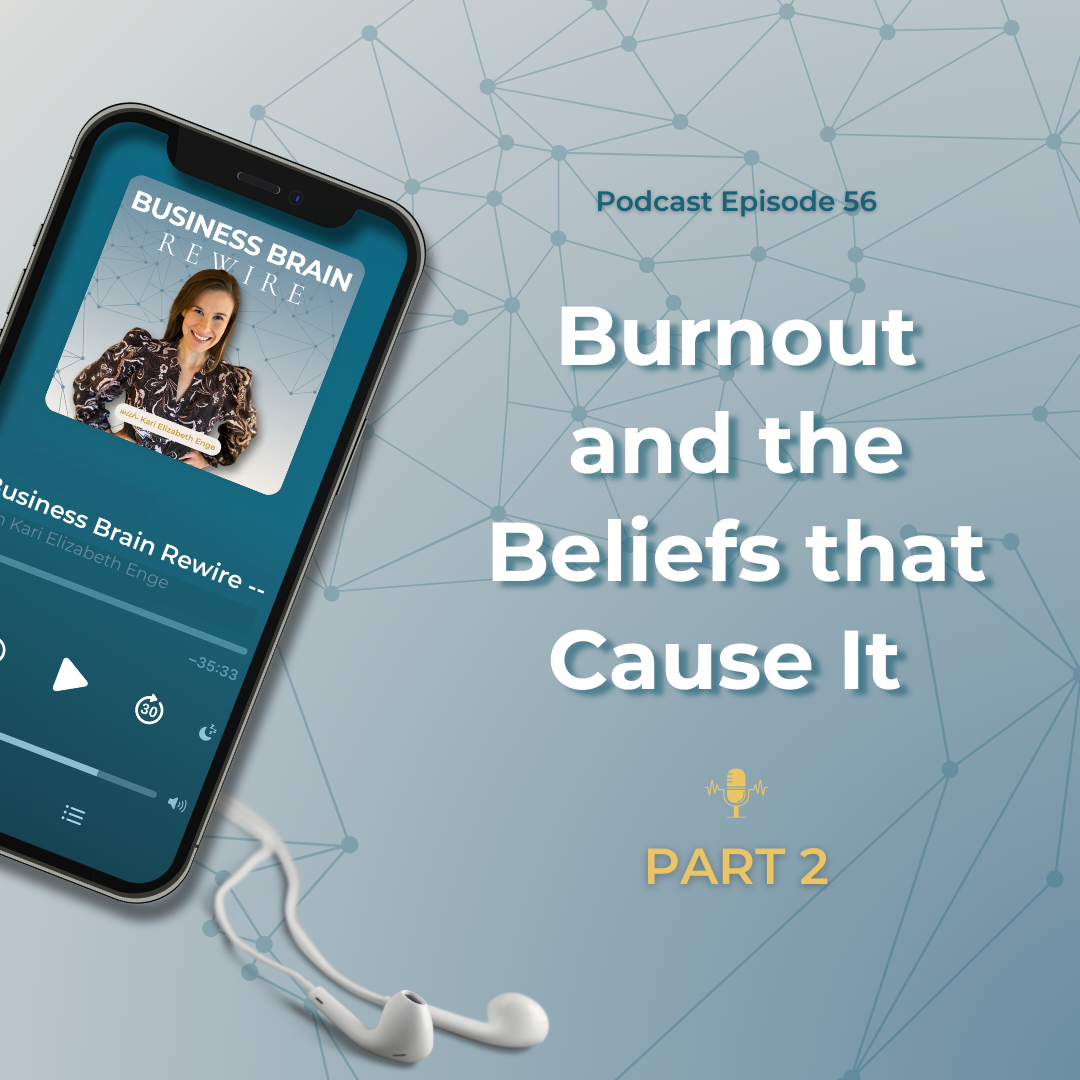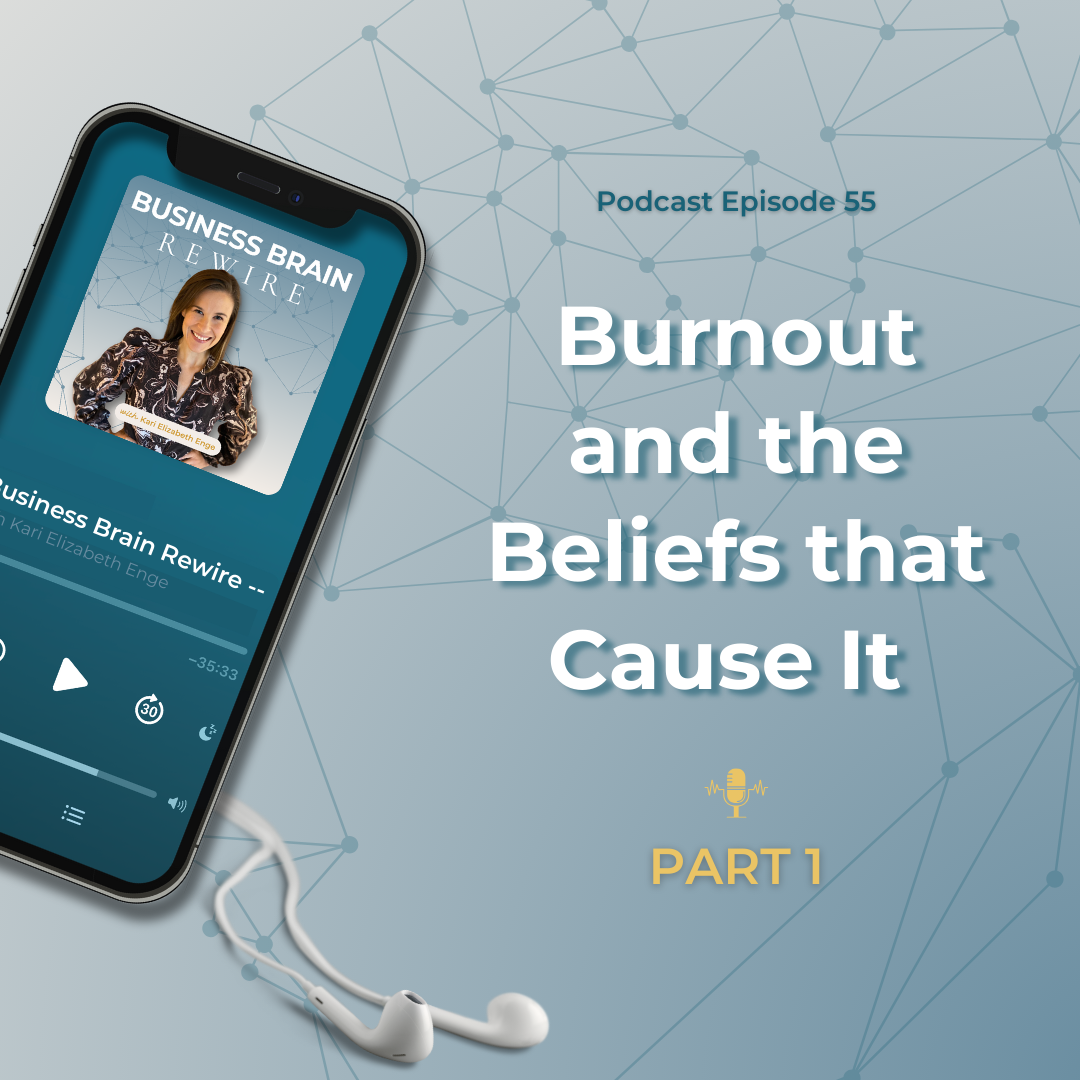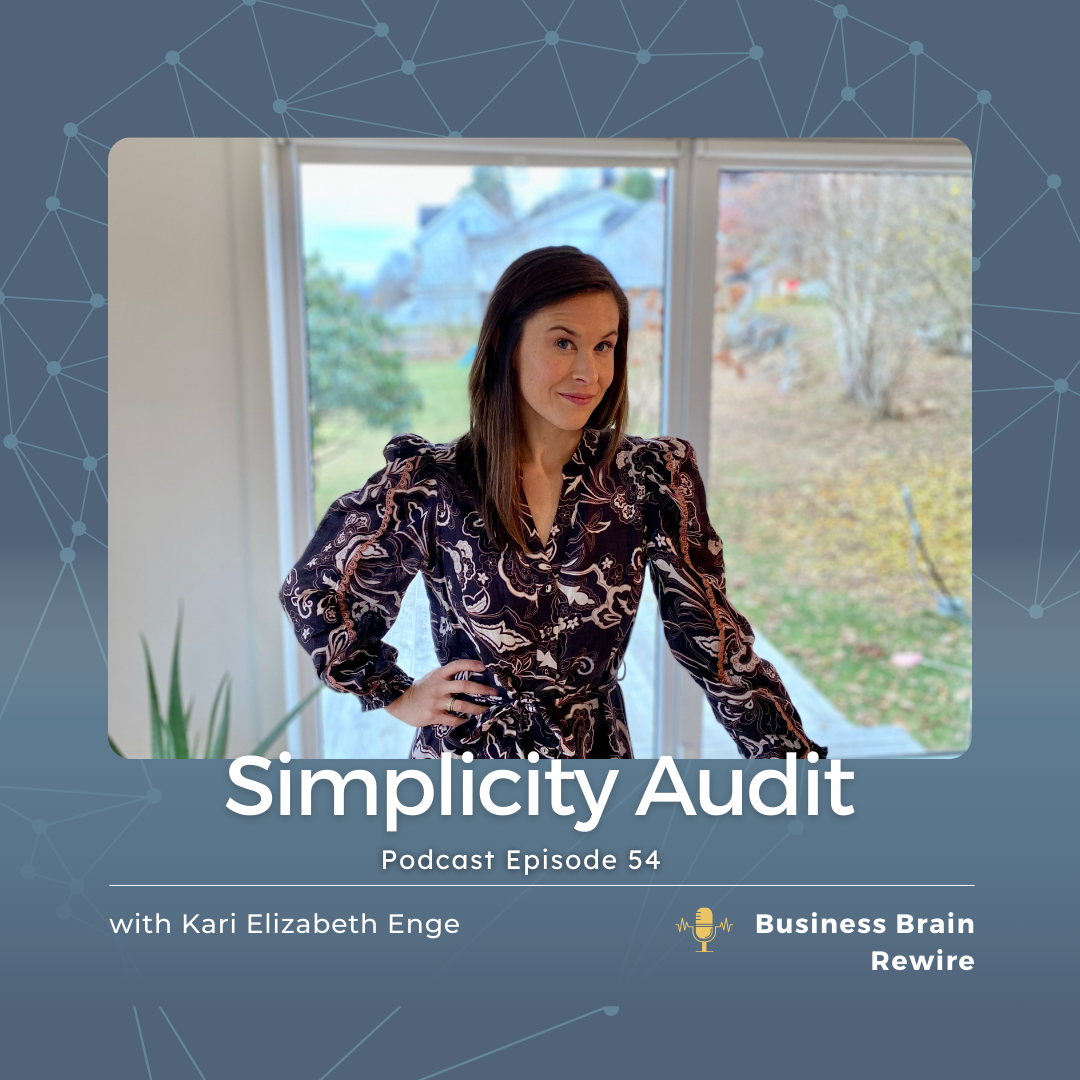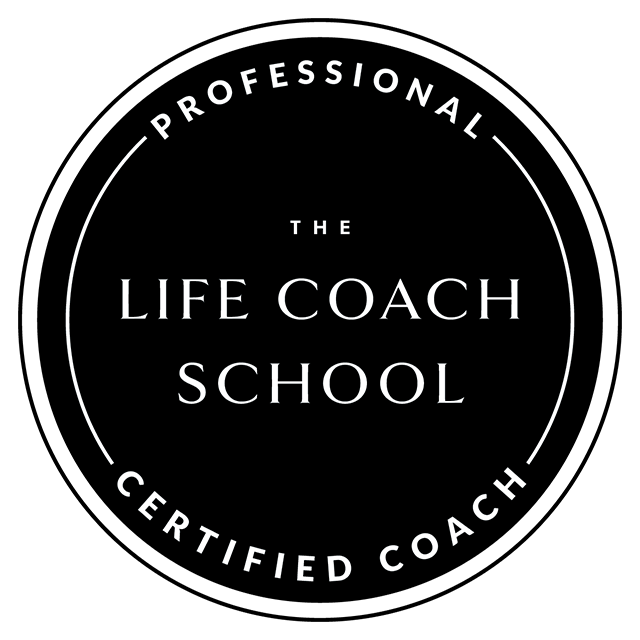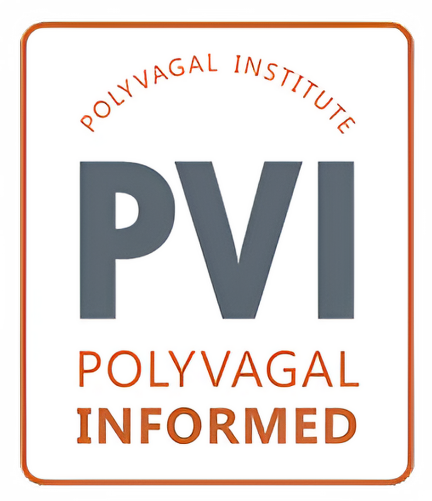Understanding the power of creating emotional connection is a game changer for founders.
When you are focused on tasks, moving things forward, reaching goals and problem-solving, it’s easy to fall into focusing on task orientation and the gap you are trying to fill.
This creates emotional disconnection from yourself, your mission, your people, and your customer, which hinders your brain’s high-performance ability. Your brain starts to scan for threat, assess risk, and filter things through a lens that is not as strategic as when you are emotionally connected.
On the other hand, when you are zoomed-out and emotionally connected to yourself, your purpose, your people, and your customers, you can move the needle faster and more effortlessly because you are fully accessing your Prefrontal Cortex and Reticular Activating System in your brain. Emotional connection also helps your actions ‘land’ because you can emotionally connect to customers, partners, and team-members.
In this episode, I teach these three connection points so that you move up the Emotional Connection Scale – a tool I teach founders in my Simply Sustainable Program that helps them sell more and reduce stress:
Step 1: Emotional Connection to Yourself
Before you can emotionally connect with anyone else—whether it’s customers, collaborators, or partners—you need to be deeply connected to yourself. This means believing in your own capabilities, your value, and your worth as a founder.
Far too often, entrepreneurs struggle with self-doubt and imposter syndrome, which creates a disconnect between who they are and what they’re trying to accomplish. If you don’t believe in yourself, it will be hard to stand in front of investors, pitch to potential customers, or make confident decisions for your business.
But the way you build this emotional connection is not about mantras or “trying harder.” So, tune-in for tips on how to build more confidence in yourself!
Step 2: Emotional Connection to Your Product
Once you’ve built a strong connection to yourself, the next step is to create an emotional connection to your product or service. You need to actually believe in the value that your offering brings to your customer.
If you’re not excited about your product, how can you expect anyone else to be?
The key here is to genuinely love what you’re putting out into the world and to be connected to the purpose and mission behind it. When you believe your product or service is something that people truly need, it becomes much easier to communicate that value to others.
A good test: Do you feel like purchasing your product is a total no-brainer? Like they would be CRAZY not to take you up on it? Do you know how URGENT it is to get it into the hands of your people? If not, you have some work to do here.
Tune-in for tips on how to build up belief in your product.
Step 3: Emotional Connection to Your Audience
Here’s where the magic happens: building emotional connection with your customers. It’s not enough to just imagine a customer avatar on a piece of paper.
You need to deeply empathize with their emotions, desires, and pain points. You need to be passionate about helping them on a deeply human level.
Only then can you create marketing and sales efforts that truly resonate with them and feel aligned and authentic to you at the same time.
When you’re emotionally connected with your customers, you’re not selling to them—you’re serving them. You understand their needs on a deeper level, and you’re genuinely excited to help them solve their problems.
True impact can be created when you sell from this place, and how I teach all my founders to sell. Tune in today’s episode to gain more insights into this philosophy.
Step 4: Aligning with Your Future Vision
Once you’ve established emotional connection to yourself, your product, and your audience, the final step is to emotionally align with your future vision. This is where things get exciting because it’s about stepping into the future *now*.
Many entrepreneurs get stuck thinking they’ll finally feel successful, confident, or relaxed once they hit certain milestones. But the truth is, you need to start feeling those positive emotions *now* to make the journey successful and sustainable.
Emotional connection is not just about marketing or selling—it also pushes collaboration. The more emotionally connected you are with yourself, your product, and your audience, the easier it will be to attract the right collaborators, mentors, and investors.
At the conference, I experienced this firsthand.
After sharing my story and insights with the room of 70 women, I had incredible conversations with people who were genuinely excited to collaborate. Why? Because they could feel my passion and emotional connection to what I was doing.
Some Final Thoughts:
Remember, there’s an abundance of opportunities out there for you—whether it’s customers, partnerships, or collaborators. When you build emotional connection with yourself and what you’re offering, opportunities will come to you naturally.
Building emotional connection isn’t just a nice-to-have. Whether you’re just starting out or you’re scaling your business, connecting emotionally to yourself, your product, your customers, and your future vision will fuel your success.
The Simply Sustainable program is designed to help you build and strengthen these emotional connections every step of the way. Through meditations, visualizations, and practical exercises, you’ll cultivate the emotional foundation that fuels your success.
You’ll get rid of imposter-syndrome, fear of visibility, and the worry that you are being “sleazy” with your marketing. You’ll also form deep clarity in your vision and be able to step into that vision with compelling messaging so your customers come along with you.
If you’re ready to learn more about how to build emotional connection in your business, check out the program below.
In This Episode, You’ll Learn:
- The importance of emotional connection for entrepreneurial success.
- The 4 connection points on The Do Business Better Emotional Connection Scale
- How to build emotional alignment with yourself, your product, and your audience.
- Strategies to experience desired emotions NOW, not later.
Mentioned in Today’s Episode:
Increase sales and lower stress using DBB’s proven CEO System by learning more about the NEW Simply Sustainable Coaching Program for purpose-driven founders.
Sign up for the Oslo Innovation Week Daring HER Virtual Encore on October 9th from 12:00pm (noon) Central European Time. American founders! Do not worry, a recording will be sent out for those who can’t make it this time.
Find more info on Instagram @DoBusinessBetterSchool and check the show notes for signup options.
Transcript:
Hello, hello, hello and welcome to today’s show. I just spoke at a conference here in Oslo called Oslo Innovation Week. I was speaking to female founders specifically. The conference was [00:01:00] called Daring HER -The Science of Success for female founders. I shared the latest neuroscience, mind, body tools for founders to use, to really reach their goals with more ease. We are actually going to do an Encore, a virtual Encore version of that talk coming up.
So if you’re listening to this live in October of 2024, you can go to the show notes, find that virtual Encore version and sign up so that you can see my talk from wherever you are in the world. So take advantage of that. But today, I want to talk about an “aha” moment that I had at the event. And how it relates to you being able to connect emotionally with humans as a founder and therefore being able to be more successful because of how you are able to [00:02:00] collaborate with other humans. One of the things that I talked about in the presentation and my talk, was about how often we experience an emotional disconnect as founders, and we get all alone inside of our heads and we kind of isolate there and how that emotional disconnection really wreak havoc on the ability for our brain to function, in a very high performing way. But also that it just doesn’t feel good. So today I want to talk about how you can use emotional connection to collaborate better as a founder. I also want to share you just like some tidbits of wisdom that I have gained recently, just kind of navigating my own collaborations as a founder. I’m going to share some mistakes I’ve made and things that you might want to keep in mind [00:03:00] as you navigate collaborations in your own business.
So to kick this off, I want to just share a little bit about how powerful yesterday was for me. I left this event after speaking to about 70 women in the room. And then having them come up to me afterwards, like probably 20 of them to just say, thank you so much. This was so helpful. And to share some of the things that they’ve been struggling with and how they were able to have a big aha moment and work through that during the talk was just so profound.
I was just moved at one point to tears because it felt like the honor of a lifetime to be able to facilitate someone moving through something they’ve been struggling with. And to have a transformational moment where they really [00:04:00] understood why they had been feeling the struggle and then why that made so much sense in a way that really validated them and then had the tools to move forward in a more effective way.
That for me was just so powerful for me to experience. And I left the day, after having connected with these customers in a way, even though they didn’t pay to be at that talk, they were engaging with me for free. To connect with my customers in that way, fueled me up so much. And so I want to share with you a little bit about why emotional connection is so important for you as a founder and how you can experience it, regardless of where you’re at in your business. You might be listening to this saying like, Kari, I don’t get to speak to 70 people.
I don’t have 70 people show up to hear from me. I feel like I’m just speaking into the abyss of social media [00:05:00] or my newsletter and I just can’t emotionally connect with those people. I just feel all alone. And today I want to first talk about what emotional connection is and how you build it because there’s a couple of different steps to emotional connection.
And in order to experience the deep, emotional connection that I did with those women in the room, there’s a couple of things that have to happen first. And I think this relates to you just generally as a founder. But it also relates to how well you will collaborate and sell and do marketing . So, this is just so foundational. But before we can start to talk about how to get emotionally connected. We need to talk about what it actually is.
So I want you to think about some of the desires that led you to become an entrepreneur. If you’re listening to [00:06:00] this podcast, it probably means that you are a purpose-driven individual, which means that you maybe wanted to feel a sense of purpose with your work, you wanted to feel more fulfilled. Maybe you wanted to feel more of a sense of empowerment or freedom. Maybe that was time freedom or financial freedom. Maybe there was a certain social or environmental cause that really drew you to it and you felt really pulled and called to, to work on that problem. Or maybe you just had some unexplained emotional pull toward entrepreneurship, regardless of what emotions were driving you toward entrepreneurship. It’s important that you remember that it actually was an emotion that drew you to found a company and it doesn’t matter if you are the most, male of males, if I can say that if you’re not really in touch with your feelings and you don’t think feelings are useful and you think they’re just fluff. [00:07:00] The human brain, the only reason why we take action is because of how we’re feeling in the moment or how we think we’ll get to feel once we take the action or achieve the goal. So it doesn’t matter what kind of human you are, what gender you are. Feelings are actually everything when it comes to your action taking. And what I think is really interesting is oftentimes we get in a disconnect as entrepreneurs because we get in the weeds during the day to day. We’ve got deadlines and we’ve got goals and we’re tracking KPIs and we might have investors or just ourselves ramping up the pressure to do things on time or to do things really well. And this can make us lose the emotional connection that we wanted originally when we became founders.
I like for founders to think about all the feel good emotions they thought they would have [00:08:00] as an entrepreneur or the feel good emotions they thought they would experience once they reached some sort of milestone or success as an entrepreneur. And then I think it’s helpful for them to think about those idealistic emotions that they really want.
And then to check in with themselves about how they’re feeling now, there’s often a disconnect. So we feel a certain way now, we might feel a little rushed, a little busier than we’d like to be. We might not feel really proud of ourselves, or we might not feel like a sense of accomplishment. We might feel like an imposter maybe.
We might not feel confident. And then we look out into the horizon at a future version of ourselves, a future version of our companies and we imagine that we’ll feel more confident. We imagine that we will be less busy. Maybe things will have slowed down once we figure out this next challenge. And we think, oh, if we can just work hard and take action and figure things out, then [00:09:00] eventually we’ll scurry and walk ourselves to that place where we’ll feel differently. This is truly a disconnect. Because we actually have to feel the future feelings, those helpful feelings, now, on the way to the goal before we’ve reached the goal, because those feelings actually motivate a higher quality action in us now. These helpful emotions, these emotionally connected feelings actually regulate the central nervous system and tap you into a higher performing brain where better ideas and better strategies will come out of you.
And also your actions will land better. Because when you get into the room with that collaborator or that partner, or that investor, or that customer, because we are very [00:10:00] emotionally connected creatures, if you are really regulated and emotionally connected with what you’re doing, the other person on the other side of the table from you will be like, oh, you’ll be like a magnet.
They’ll want to be a part of what you’re doing. And so we have to feel these emotionally connected, helpful feelings now, in order to reach the goal. We cannot postpone how we want to feel into the future, and I think this is one of the most amazing pieces of truth that the coaching industry has given us. That we can think what we want to think. We can feel how we want to feel now, regardless of the circumstance. We as humans actually have this skill set. If we’re willing to do it, right? We don’t have to wait like victims until everything’s lines up in order for us to just cut off, feel the way we want to feel. And that’s the first really important thing that I want you to take away from today’s episode is that if [00:11:00] you would like to collaborate with other people more easily. If you want to bring on investors to become mentors to become advisors. If you want to become a better marketer or seller. Your emotions are number one to make that happen.
Once you feel emotionally connected to the human across the table, magic can happen in a way that feels really energizing and good to you.
And that’s what happened to me at daring her at this conference. Now. In order for you to build emotional connection, you can do a couple of exercises to help you to tap into it, but it actually happens on a scale. So you have to start at the beginning of the scale and then you have to be emotionally connected at that little baby point. And then you can build emotional connection to different things as you move up [00:12:00] the scale.
The reason I was able to feel so emotionally connected with the audience, at this conference, is because I felt emotionally connected to other things first. And that was like my oxygen mask. I put the oxygen mask on myself first and then therefore I was able to apply it to other people.
Oftentimes entrepreneurs, come to me, and they say, Kari, you know, I’m trying to get better at marketing selling. And I’ve heard that I need to imagine my customer avatar when I’m writing copy. Right. And like a very sort of tools and tricks and sort of bro marketer kind of mindset of here’s just the thing you need to do in order to make sales.
Right. And while I agree with this piece of advice on the surface. The only reason why you would imagine a customer avatar before you write a copy is because you need to [00:13:00] emotionally connect to the person who you’re writing to. And visualizing or just looking at a customer profile customer avatar piece of paper, with a picture, and what this person likes, and what these person’s pain points are, that doesn’t necessarily emotionally connect you to that person.
And so in order to do some of these things in order to emotionally connect with the person who you’re trying to interact with, that’s really hard, if you are not emotionally connected to a couple of things first.
So, let me explain to you the emotional connection scale now, so that you can create this emotional connection with the first parts. Before you try to emotionally connect with a collaborator or a customer. Okay. The first piece of emotional connection that you need to create is emotional connection to yourself.
If you are feeling like you’re not enough. If you’re not capable. [00:14:00] Then there’s no amount of emotional connection to another human being that can be created. Because again, you don’t have that foundation.
So it’s really hard to stand up in front of investors. It’s really hard to stand up in front of customers, if you don’t have that baseline.
So in the beginning, I think this is number one. I was walking with some friends this week in the forest and they actually are two female founders who are just getting started. And I mentioned to them, you know what? I think I know somebody who would be really helpful for you to chat to. And. One of them said something that I hear a lot, which is like, you know what? I think I’ll be ready for that next year. I think I’ll be ready for that intimidating conversation in the future.
And this is what that lack of belief in [00:15:00] yourself, that’s so common in the beginning, does. It keeps you from wanting to collaborate. It keeps you from wanting to emotionally connect to another human being because it just feels too intimidating. Now. There’s actually nothing wrong with going through this phase.
And I think it’s a very normal and needed phase in the entrepreneurial journey. So if you’re there: don’t worry. Just use tools to work through it. Oftentimes your brain has to get on board with your new identity and that can take some time and it takes some time for you to fundamentally feel safe, to jump into this new version of yourself. And so you don’t always need to, you know, jump into the deep end, into the cold water, instantly because your nervous system needs to stretch without snapping the rubber band.
And oftentimes, we just need some time to acclimate. So there was really nothing wrong with what this person said, but I think it’s just a really great example of how [00:16:00] collaboration is really impossible when we don’t have that foundation first.
Once you feel fundamentally capable and enough, then the next part of the scale that you need to build is belief that you have what you need right now.
That you have the time that you need, that you have the support that you have, the resources that you need in this moment. Okay, so it shifts from a cell focus of , I can handle this. Two, I have everything I need, inside of me or around me. Once you’re really believing: I am enough, I’m capable and I have what I need.
Your focus moves from a self focus where your brain will focus more on judgment and it’ll feel like you’re against the world or working for approval. It will move to a more neutral place where you can really start to get more innovative and creative around your [00:17:00] products.
Because again, you have that baseline of connection with yourself. So at this point, you can move to the second point on the scale, which has connection with your product.
And you can start to get inspired about your product, so much so that you start to ramp up the emotional connection with what you’re doing, and you can start to really believe that it’s valuable. And once you’re in this emotionally connected place on the scale, if you keep going, then eventually your brand’s going to say, you know what?
This is of value. People need this. I can share this value with the world. Not only do people need this, but they want this. And they want me to deliver it to them. So the very top of the scale, like the last place on the scale is where you’re really believing. I am safe to be seen to deliver this incredible [00:18:00] value to this other human being. And you’re really seeing how you benefit from that and how they benefit from that.
And it’s a really like us focus. It’s service, it’s gratitude. It’s empathy. It’s engagement at the highest level. Where you’re really seeing all the other humans and you’re just desiring to go out and help them. And it’s really not about you anymore. There’s so much more confidence that comes with your selling or your collaboration. That comes when you’ve gone up the scale of belief in yourself believing in your product and then ultimately belief in your customer.
So these are the three points on the scale. And this is what happened at this conference. I’m constantly building up new levels of belief in myself and new levels of belief in my product. And therefore it’s getting easier and easier to connect with other humans in a way that feels really safe.
Now. [00:19:00] I want you, to realize that the way you get these really great partnerships, collaborations, conversations with customers. They are possible. The level that I’m doing that at now is possible because of the confidence and belief I have in myself and in my product. It’s really helpful for you to constantly be, massaging that and growing that and moving that forward and strengthening that so that you can continue to just, expand the kind of conversations that you’re having.
So you might be asking, how do I move up the emotional connection scale? How do I build belief in myself and in my product and in my customer. This is something we do a lot of inside of my coaching program, Simply Sustainable. We have several video training modules on it. We also have a library of [00:20:00] resources that have meditations and visualizations for you to help to really connect with who you are as a founder in your enoughness in your capabilities, in your strengths. To ground yourself and get excited about what your product is and what it does for people and why it’s of value. As well as meditations to help you to connect emotionally to your customer. These are fantastic tools to use on a daily basis, but also before you’re going to go into any type of visibility.
So before the investor meeting, or before you’re going to write copy. it’s not just about looking at a customer avatar and then going back into how do I get this right, that’s emotional disconnection. It’s about maybe looking at that customer avatar, but then knowing how to move yourself emotionally so that your words really inspire in land. And that’s, what we, have a vault full of all types of resources to help you inside of Simply Sustainable. [00:21:00] So I’ll link up to the program in the show notes.
So that building belief, building emotional connection on those three levels of the scale, I think is step number one. From there and only once you’ve done that, you’re ready to start to connect with the future vision of your company. And I think that this is where I’m at right now, and it’s making collaboration’s very easy and seamless and exciting and fun.
I have, I think just, bursted through a new level of clarity on this literally in the last week. And I think that’s why I had so many great conversations at Oslo innovation week, because I’m just at this next level of clarity, and confidence about where I’m going and not only who I am now, but who I’m going to be three steps [00:22:00] ahead, and like stepping into that emotionally.
So a great thing for you to do, to keep moving up this emotional scale so that collaborations and customer interactions are really fueled is to understand where you are now and the next three steps for your company. So this is not about a timeline. I think that most founders get caught up in the traditional way of goal setting, envisioning where they’re in 10 years, I’m going to be so and so, and it’s just so arbitrary and it’s not that helpful because it ramps up, the stress response, oftentimes because it puts a deadline on you.
Oftentimes timelines are just hand in hand with a deadline and that can really dysregulate your nervous system. So, what I like to think more about is what are the next three steps, regardless of the timeframe. I mean, you might have a timeline in mind, but that doesn’t really matter. So I’m really clear on what the next three steps are for my business.
And I [00:23:00] know that the third step might alter and change as I get started with step one and two. And that’s okay. There’s also quite a bit of questions that I have for step three. But just me knowing that general direction for myself can really help me to say yes, more easily because I really can see, oh, that person matches up.
It also allows me to say no, thank you. You’re not really matching up with where I’m going to go. And that’s totally okay. So it gives me this inner compass, this inner knowing, to be able to make decisions, more easily. And I think that’s, what’s what I was experiencing this week is just this like inner knowing of who I am and where I’m going as a company.
And that just really grounded me with all these interactions and potential opportunities that were presented to me because people were coming up to me afterwards saying we should collaborate and we should do that, and I want to talk to you, and it was just like a lot of excitement. So [00:24:00] you have to filter through what really aligns with you and what does not and who your people are and who your people are not.
So I think that’s the next step of this emotional scale. So it starts with belief in yourself then believe in your product or your service, then belief in your customer and emotionally connecting to your customer and then connecting with the future vision of where you’re going in those next three steps.
When you have all of these things firing, all these beliefs, and you really understand who you are and you’re grounded in that, I promise that collaborations are gonna fly to you. And it’s more about you discerning which ones are for you and which ones are not. And that’s a really great place to be. I want to wrap up today’s episode by just telling you that I’ve had a couple of recent failures as well regarding collaboration. And I wanted to share some of my early learnings about [00:25:00] that with you, because I think it’s really relevant for this conversation today.
I’ve had to go separate ways with someone who I was trying to collaborate with recently. And we ended that collaboration in a really amicable way. But we had some friction for, I guess, like maybe a week or two, as we were trying to navigate, like why we weren’t a good fit. And I made a couple of leadership mistakes there that I’ll maybe shoot a different podcast about that in another time.
But what I want to share with you today regarding some of those lessons learned really relates to emotional connection. One of the things that I do when I experience a failure or I feel like something just didn’t go exactly like I would’ve liked it to, or if I’m just feeling like a disconnect, I sit down and I really reflect on it. [00:26:00] I try to see the other person’s point of view to really see if there’s some truth there.
Oftentimes people can see you so much more easily and clearly then you could see yourself. And I think when we mined these things for little golden nuggets, and we mind these hard moments for value, it just makes us so mature and it just ensures that we continue with this growth mindset of improving and learning rather than just going through a hard time and then kind of finally getting over the neck of that emotion and then just moving on. I always want to make sure that I have mind every single experience that I’ve had for every learning that I’m supposed to get from it.
And so I was sitting down reflecting on. What were the red flags? What were the cues that I missed early on, that might’ve been there that I just completely bypassed. Because I often feel like failure is only a result [00:27:00] of missing a cue, or way, way earlier on, and we just we weren’t patient enough, we weren’t slow enough, we were just too self focused enough to pick up on it. Now, I’m not talking about like sales and marketing failures, where you launch a product and then it didn’t sell well. Right. I’m just talking about just a general thing, maybe a relationship or something else inside of your business, where you felt like, you know what, I didn’t really handle that well.
And so I was thinking about this and one of the things that I really discovered is you know what, I picked up on a gut feeling, that just wasn’t quite right pretty early on. And I just kept on moving at a fast pace, just because the momentum was going, we just had already decided that we were going to collaborate. And I didn’t slow down to investigate how this collaboration was really aligned with me, my personal values, my personal beliefs, that first step on the emotional connection scale is [00:28:00] you. So I really didn’t check in to say okay, how is this collaboration matching up with that? And then how has this collaboration matching up with the product? And how was this collaboration at matching up with the customer? And then how was this collaboration matching up with my vision? I didn’t really do that.
I did it at a shallow surface level way. And then I got just impatient and just in the momentum of moving things forward that I moved this person forward, this collaboration idea forward, knowing that it actually wasn’t perfect. It wasn’t ideal.
And I was laughing at this when I was reflecting, because I’ve made this mistake with lower level hires before with hiring interns or hiring sales and marketing roles where I just had a couple of concerns in the interview. I’m just not quite sure about one or two things, but it’ll probably be fine. They’re good on all the other things, and every single [00:29:00] time that hire didn’t work out.
And so that’s kind of what I’m sharing here is that there were some gut concerns that were there, that weren’t perfectly aligned and I was just like, nope, let’s just keep moving forward. The lesson here for you is to listen to your gut, to listen to some of these concerns. It might not feel like a big, inner knowing, that’s not what it felt like, but it was a comment to my husband, I’m like, you know, so-and-so said this and I don’t really know. It can just be a concern or a thought or a conversation that you’re just prompted to have maybe at the end of the day with the person you live with.
Right. These are signposts that the emotional connection is not there and with collaborations, there’s just no need for this. Ever. And I think that that’s one of the big aha moments that I’ve had recently. There are so many people to collaborate with. I was reminded of this at the conference, there’s just so many opportunities.
It’s kind of like dating, right? There’s just so [00:30:00] many fish in the sea that it’s just really not necessary to jump in with someone who’s not in alignment on that emotional scale with you. For your values for who you are. For what you want your product to be and your service to be. How you want your customers to engage with it and where the vision, where the future’s going. If it’s not a perfect match, just leave it.
There’s so much abundance out there, so much opportunities, so much potential that you never need to feel like you just need to grab up an opportunity because it might slip you by. I had one conversation. It was such a lovely conversation at the conference afterwards.
And she came up to me and she said, you know what? I’ve had just such an aha moment. ’cause she said, I started my first company and I grew that company to a pretty high level. But I ultimately was prompted to leave that [00:31:00] company. I made a hard decision to leave it because I was burned out and I wasn’t emotionally connected anymore.
And now I see why I would’ve done things differently. If I wouldn’t have got in that really scarce, grab up all the customers or grab up all the collaborations or grab up all the opportunities when they were presented to me. There was only so much available and if we didn’t grab it now, it wouldn’t be there.
And she really had a shift in her thinking that now she was just so grateful for that she could bring into her next business. So as you work on improving the emotional connection you have with yourself, with your customer, with your product, with your vision. I want you to also know that collaborations, there’s just so much opportunity out there. And the more you focus on who your being and your beliefs, about all of these areas, you’re going to attract lots of collaborations, and then [00:32:00] you’re just going to be able to pick and choose. It’s not going to be something that you have to be really scarce and needy with.
And when you wait for the right collaborations and those collaborators are really aligned on all levels of the scale, then you will naturally be able to stay emotionally connected with those people, with your partners, with your collaborators. And you will be able to serve them so much better. I think one of the reasons why I had some leadership failures is because I wasn’t emotionally connected to that cloud operator. But it was only because I wasn’t emotionally connected to the other areas first. And so this is just a leadership tool as well that will just ensure that you are naturally going to take care of people around you. In a better way.
So I want you to remember, these parts on the emotional scale, build them [00:33:00] up. Start with step one belief in yourself. Once you’ve conquered that you can move on to the next ones. You can also try to build them all at the same time, but I want you to know that connection to your customer connection to your vision will be very hard, if you don’t have connection with yourself and your product first. And then after that, I want you to remember the abundance of collaborations that are available to you, the abundance of customers that are available to you. And to just focus on emotional connection and gratitude and service to those people while staying in alignment with you and your values.
And I promise that you’re going to reach your goals with so much more ease. You’re going to have really rewarding collaborations that feel so safe and aligned for you. All right. I hope. That this episode was helpful to you. I literally recorded this totally off the cuff. I have no script. I literally just have a bullet point of notes here, [00:34:00] scribbled down, because this is so raw.
This is something that, although I taught at the conference, I have so many personal lessons learned about this just recently in the last couple of weeks. So thank you for hearing me out. I hope you have a wonderful week ahead, really focusing on how you use your emotional state in your business and building up your beliefs as you go out there. And you serve customers and it turn to collaborations. Have a wonderful week serving the world, making sales and making time for self care. And I’ll see you here back next week. Take care.
